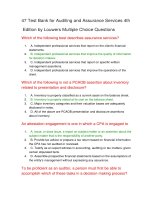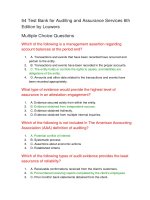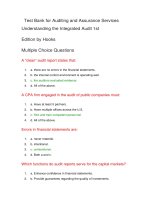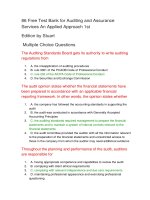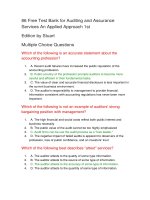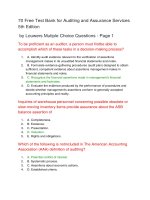110 test bank for auditing and assurance services 5th edition louwers
Bạn đang xem bản rút gọn của tài liệu. Xem và tải ngay bản đầy đủ của tài liệu tại đây (145.51 KB, 32 trang )
110 Test Bank for Auditing and Assurance Services 5th
Edition Louwers
True - False Questions
For independent auditors of financial statements in the United States,
established criteria largely consist of the generally accepted accounting
principles (GAAP).
1.
True
2.
False
The AICPA licenses CPAs to practice in the United States.
1.
True
2.
False
Assurance service is the systematic process of objectively obtaining and
evaluating evidence.
1.
True
2.
False
Internal auditors perform only operational audits.
1.
True
2.
False
Four conditions that create demand for reliable information arecomplexity,
remoteness, timeliness, and consequences.
1.
True
2.
False
The objective of internal auditing is to assist members of an organization to
effectively perform their obligations.
1.
True
2.
False
The AICPA Statement on Auditing Standards defines auditing morebroadly
than the AAA definition of auditing.
1.
True
2.
False
The PCAOB audit objective related to the completeness assertionis to
establish evidence that assets, liabilities, and equities actually exist.
1.
True
2.
False
Expanded scope governmental auditing includes economy and efficiency and
program results audits.
1.
True
2.
False
Government auditors perform both financial and performance audits.
1.
True
2.
False
Assurance services are independent professional services that improve the
quality of information or its context for decision makers.
1.
True
2.
False
Independent auditors are employees of the client.
1.
True
2.
False
Financial decision makers obtain their accounting information from lenders of
funds.
1.
True
2.
False
Professional skepticism is an auditor's tendency not to believeanyone.
1.
True
2.
False
The concept "professional skepticism" requires that auditors assume
management is dishonest and should not be trusted.
1.
True
2.
False
Evidence consists of assertions about economic actions and events.
1.
True
2.
False
The lending of credibility to financial information is known ascertification.
1.
True
2.
False
The purpose of obtaining and evaluating evidence is to ascertain the degree
of correspondence between the assertions and established criteria.
1.
True
2.
False
The ASB balance audit objective related to valuation or accuracy is to
determine whether proper values have been assigned to assets, liabilities,
equities, revenues, and expenses.
1.
True
2.
False
Financial decision makers demand reliable information that is provided by
accountants.
1.
True
2.
False
Mutiple Choice Questions - Page 1
The engineering department at Omni Company built a piece of equipment in
the company's own shop for use in the company's operations. When looking
at the ending balance for the fixed asset account, the auditor examined all
work orders, purchased materials, labor cost reports, and applied overhead
that were capitalized as part of the equipment costs. Which of the following is
the ASB balance assertion most closely related to the auditor's testing?
1.
A. Existence.
2.
B. Completeness.
3.
C. Rights and obligations.
4.
D. Valuation.
The audit objective that all the transactions and accounts presented in the
financial statements represent realassets, liabilities, revenues, and expenses
is related most closely to which of the PCAOB assertions?
1.
A. Existence or occurrence.
2.
B. Rights and obligations.
3.
C. Completeness.
4.
D. Presentation and disclosure.
What is the term used to identify the risk that the client's financial statements
may be materially false and misleading?
1.
A. Business risk.
2.
B. Information risk.
3.
C. Client risk.
4.
D. Risk assessment.
An attestation engagement is one in which a CPA is engaged to
1.
A. Issue a report on subject matter or an assertion about the subject matter that is the
responsibility of another party.
2.
B. Provide tax advice or prepare a tax return based on financial information the CPA
has not audited or reviewed.
3.
C. Testify as an expert witness inaccounting, auditing, or taxmatters, given certain
stipulated facts.
4.
D. Assemble prospective financial statements based on the assumptions of the entity's
management without expressing any assurance.
In order to be considered as external auditors with respect to government
agencies, GAO auditors must be
1.
A. Organizationally independent.
2.
B. Empowered as the accounting and auditing agency by the U.S. Congress.
3.
C. Funded by the federal government.
4.
D. Guided by standards similar to GAAS.
Which of the following best describes assurance services?
1.
A. Independent professional services that report on the client's financial statements.
2.
B. Independent professional services that improve the quality of information for
decision makers.
3.
C. Independent professional services that report on specific written management
assertions.
4.
D. Independent professional services that improve the client's operations.
Which of the following best describes the main reason that independent
auditors report on management's financial statements?
1.
A. Management fraud may exist, and it is likely to be detected by independent auditors.
2.
B. The management that prepares the statements and the persons whouse the
statements may have conflicting interests.
3.
C. Misstated account balances may be corrected as the result ofthe independent audit
work.
4.
D. The management that prepares the statements may have a poorly designed system
of internal control.
The underlying conditions that create demand by users for reliable
information include all of the following except
1.
A. Transactions are numerous and complex.
2.
B. Users lack professional skepticism.
3.
C. Users are separated from accounting records by distance and time.
4.
D. Financial decisions are important to investors and users.
5.
E. Decisions are time sensitive.
Which of the following best describes the primary role and responsibility of
the independent external auditor?
1.
A. Produce a company's annual financial statements and notes.
2.
B. Express an opinion on the fairness of a company's annual financial statements
3.
and footnotes.
4.
C. Provide business consulting advice to audit clients.
5.
D. Obtain an understanding of the client's internal control structure and give
management a report about control problems and deficiencies.
The auditor's judgment concerning the overall fairness of the presentation of
financial position, results of operations, and cash flows is applied within the
framework of
1.
A. Quality control.
2.
B. Generally accepted auditing standards, which include the concept of materiality.
3.
C. The auditor's evaluation of the audited company's internal control.
4.
D. The applicable financial reporting framework (i.e., GAAP in the United States).
The audit objective that footnotes in the financial statements should be clear
and expressed so that the information is easily conveyed to the readers of the
financial statements is related most closely with which of the ASB
presentation and disclosure assertions?
1.
A. Occurrence.
2.
B. Rights and obligations.
3.
C. Comprehensibility.
4.
D. Understandability.
Because of the risk of material misstatement, an audit of financial statements
in accordance with generally accepted auditing standards should beplanned
and performed with an attitude of
1.
A. Objective judgment.
2.
B. Independent integrity.
3.
C. Professional skepticism.
4.
D. Impartial conservatism.
The audit objective that all balances include items owned by the client is
related most closely to which one of the ASB balance assertions?
1.
A. Existence.
2.
B. Rights and obligations.
3.
C. Completeness.
4.
D. Valuation.
Inquiries of warehouse personnel concerning possible obsolete or slowmoving inventory items provide assurance about the PCAOB assertion of
1.
A. Completeness.
2.
B. Existence.
3.
C. Presentation.
4.
D. Valuation.
5.
E. Rights and obligations.
The audit objective that all transactions are recorded in the proper account is
related most closely to which one of the ASB transaction assertions?
1.
A. Occurrence.
2.
B. Completeness.
3.
C. Accuracy.
4.
D. Classification.
Inquiries of warehouse personnel concerning possible obsolete or slowmoving inventory items provide assurance about the ASB balance assertion
of
1.
A. Completeness.
2.
B. Existence.
3.
C. Presentation.
4.
D. Valuation.
5.
E. Rights and obligations.
In performing an attestation engagement, a CPA typically
1.
A. Supplies litigation support services.
2.
B. Assesses control risk at a low level.
3.
C. Expresses a conclusion on an assertion about some type of subject matter.
4.
D. Provides management consulting advice.
The audit objective that all transactions are recorded in the proper period is
related most closely to which of the Audit Standards Board (ASB) transaction
assertions?
1.
A. Occurrence.
2.
B. Completeness.
3.
C. Cutoff.
4.
D. Accuracy.
Which of the following is an underlying condition that in part creates the
demand by users for reliable information?
1.
A. Economic transactions are numerous and complex.
2.
B. Decisions are time sensitive.
3.
C. Users are separated from accounting records by distance and time.
4.
D. Financial decisions are important to investors and users.
5.
E. All of the above.
Which of the following is notincluded in The American Accounting
Association (AAA) definition of auditing?
1.
A. Potential conflict of interest.
2.
B. Systematic process.
3.
C. Assertions about economic actions.
4.
D. Established criteria.
The engineering department at Omni Company built a piece of equipment in
the company's own shop for use in the company's operations. The auditor
reviewed all work orders that were capitalized as part of the equipment costs.
Which of the following is the ASB transaction assertion most closely relatedto
the auditor's testing?
1.
A. Occurrence.
2.
B. Completeness.
3.
C. Accuracy.
4.
D. Classification.
Which of the following is nota PCAOB assertion about inventory related to
presentation and disclosure?
1.
A. Inventory is properly classified as a current asset on the balance sheet.
2.
B. Inventory is properly stated at its cost on the balance sheet.
3.
C. Major inventory categories and their valuation bases are adequately disclosed in
notes.
4.
D. All of the above are PCAOB presentation and disclosure assertions about inventory.
Which of the following is notan ASB assertion about inventory related to
presentation and disclosure?
1.
A. Inventory is properly classified as a current asset on the balance sheet.
2.
B. Inventory is properly stated at cost on the balance sheet.
3.
C. Major inventory categories and their valuation bases are adequately disclosed in
notes.
4.
D. All of the above are ASB presentation and disclosure assertions about inventory.
To be proficient as an auditor, a person must firstbe able to accomplish which
of these tasks in a decision-making process?
1.
A. Identify audit evidence relevant to the verification of assertions management makes
in its unaudited financial statements and notes.
2.
B. Formulate evidence-gathering procedures (audit plan) designed to obtain sufficient,
competent evidence about assertions management makes in financial statements and
notes.
3.
C. Recognize the financial assertions made in management's financial statements and
footnotes.
4.
D. Evaluate the evidence produced by the performance of procedures and decide
whether management's assertions conform to generally accepted accounting principles
and reality.
The audit objective that all balances include all items that should be recorded
in that account is related most closely to which one of the ASB balance
assertions?
1.
A. Existence.
2.
B. Rights and obligations.
3.
C. Completeness.
4.
D. Valuation.
Cutoff tests designed to detect credit sales made before the end of the year
that have been recorded in the subsequent year provide assurance about the
PCAOB assertion of
1.
A. Presentation.
2.
B. Completeness.
3.
C. Rights.
4.
D. Existence.
Assurance services involve all of the following except
1.
A. Relevance as well as the reliability of information.
2.
B. Nonfinancial information as well as traditional financial statements.
3.
C. Providing absolute rather than reasonable assurance.
4.
D. Electronic databases as well as printed reports.
Which of the following is the essential purpose of the audit function?
1.
A. Detection of fraud.
2.
B. Examination of individual transactions to certify their validity.
3.
C. Determination of whether the client's financial statement assertions are fairly stated.
4.
D. Assurance of the consistent application of correct accounting procedures
Which of the following is nota recommendation usually made following the
completion of an operational audit?
1.
A. Economic and efficient use of resources.
2.
B. Effective achievement of business objectives.
3.
C. Attesting to the fairness of the financial statements.
4.
D. Compliance with company policies.
The audit objective of presenting all transactions and accountsin the financial
statements are in fact included is related to which of the PCAOB assertions?
1.
A. Existence.
2.
B. Rights and obligations.
3.
C. Completeness.
4.
D. Valuation.
70 Free Test Bank for Auditing and Assurance Services
5th Edition by Louwers Mutiple Choice Questions - Page
2
The accounting, auditing, and investigating agency of the U.S. Congress that
is headed by the U.S. Comptroller General is known as
1.
A. The Federal Bureau of Investigation (FBI).
2.
B. The U.S. General Accountability Office (GAO).
3.
C. The Internal Revenue Service (IRS).
4.
D. The United States Legislative Auditors (USLA).
The four basic requirements for becoming a CPA in most states relate to
1.
A. Education, the CPA Examination, experience, and substantial equivalency.
2.
B. The CPA Examination, experience, continuing professional education, and a state
certificate.
3.
C. Continuing professional education, the CPA Examination, experience, and an
AICPA certificate.
4.
D. Education, the CPA Examination, experience, and a state certificate.
The probability that the information circulated by a company will be false or
misleading is referred to as
1.
A. Business risk.
2.
B. Information risk.
3.
C. Assurance risk.
4.
D. Audit risk.
In an attestation engagement, a CPA practitioner is engaged to
1.
A. Compile a company's financial forecast based on management's assumptions
without expressing any form of assurance.
2.
B. Prepare a written report containing a conclusion about the reliability of a
management assertion.
3.
C. Prepare a tax return using information the CPA has not audited or reviewed.
4.
D. Give expert testimony in court on particular facts in a corporate income tax
controversy.
The ASB transaction objective that requires the auditor to establish evidence
that all transactions and accounts that should be presented in the financial
statements are included is?
1.
A. Completeness.
2.
B. Existence or occurrence.
3.
C. Rights and obligations.
4.
D. Valuation or allocation.
The goal of operational auditing is to
1.
A. Help managers discharge their management responsibilities and improve
profitability.
2.
B. Evaluate compliance with specific laws and regulations.
3.
C. Reduce to a socially acceptable level the information risk to users of financial
statements.
4.
D. Express an opinion on the fairness of financial statements.
The PCAOB assertions made by management in financial statementsdo not
include
1.
A. Existence.
2.
B. Compliance.
3.
C. Completeness.
4.
D. Presentation.
Which of the following best describes the relationship between auditing and
attestation engagements?
1.
A. Auditing is a subset of attestation engagements that focuses onthe certification of
financial statements.
2.
B. Attestation is a subset of auditing that provides lower assurance than that provided
by an audit engagement.
3.
C. Auditing is a subset of attestation engagements that focuseson providing clients with
advice and decision support.
4.
D. Attestation is a subset of auditing that improves the quality ofinformation, or its
context, for decision makers.
The risk that an entity will failto meet its objectives is referred to as
1.
A. Business risk.
2.
B. Information risk.
3.
C. Assurance risk.
4.
D. Audit risk.
Which of the following is not a major element of assurance services?
1.
A. Independence.
2.
B. Improving the quality of information.
3.
C. Improving profitability of the client.
4.
D. Improving the context of information.
The Sarbanes-Oxley Act of 2002 prohibits public accounting firms from
providing which of the following services to an audit client?
1.
A. Bookkeeping services.
2.
B. Internal audit services.
3.
C. Valuation services.
4.
D. All of the above.
The Sarbanes-Oxley Act of 2002 requires that the key company officials certify
the financial statements. Certificationmeans that the company CEO and CFO
must sign a statement indicating
1.
A. They have read the financial statements.
2.
B. They are not aware of any false or misleading statements (or any key omitted
disclosures)
3.
C. They believe that the financial statements present an accurate picture of the
company's financial condition.
4.
D. All of the above.
The definition of performance audits does not include
1.
A. Economy audits.
2.
B. Efficiency audits.
3.
C. Financial audits.
4.
D. Program audits.
According to the AICPA, the purpose of an audit of financial statements is to
1.
A. Enhance the degree of confidence that intended users can place in the financial
statements.
2.
B. Express an opinion on the fairness with which they present financial position, results
of operations, and cash flows in conformity with accounting standards promulgated by
the Financial Accounting Standards Board.
3.
C. Express an opinion on the fairness with which they present financial position, result
of operations, and cash flows in conformity with accounting standards promulgated by
the U.S. Securities and Exchange Commission.
4.
D. Obtain systematic and objective evidence about financial assertions and report the
results to interested users.
Which of the following is an example of a regulatory auditor?
1.
A. Internal auditors.
2.
B. Big 4 auditors.
3.
C. U.S. Internal Revenue Service auditors.
4.
D. Operational auditors.
The study of business operations for the purpose of making
recommendations about the efficient use of resources, effective achievement
of business objectives, and compliance with company policies is referred to
as
1.
A. Environmental auditing.
2.
B. Financial auditing.
3.
C. Compliance auditing.
4.
D. Operational auditing.
The primary difference between operational auditing and financial auditing is
that in operational auditing
1.
A. The operational auditor is not concerned with whether the audited activity is
generating information in compliance with financial accounting standards.
2.
B. The operational auditor is seeking to help management use resources in the most
effective manner possible.
3.
C. The operational auditor starts with the financial statementsof an activity being
audited and works backward to the basic processes involved in producing them.
4.
D. The operational auditor can use analytical skills and tools that are not necessary in
financial auditing.
The organization primarily responsible for ensuring that publicofficials are
using public funds efficiently, economically, and effectively is the
1.
A. Governmental Internal Audit Agency (GIAA).
2.
B. Central internal auditors (CIA).
3.
C. Securities and Exchange Commission (SEC).
4.
D. Government Accountability Office (GAO).
Substantial equivalency refers to
1.
A. An auditor's tendency not to believe management's assertions without sufficient
corroboration.
2.
B. Providing consulting work for another firm's audit client in exchange for the other
firm's providing consulting services to one of your clients.
3.
C. The waiving of certification exam parts for an individual holding an equivalent
certification from another professional organization.
4.
D. Permitting a CPA to practice in another state without havingto obtain a license in
that state.
The risk to investors that a company's financial statements maybe materially
misleading is called
1.
A. Client acceptance risk.
2.
B. Information risk.
3.
C. Moral hazard.
4.
D. Business risk.
The process by which a CPA obtains a certificate and license ina state other
than the state in which the CPA's certificate was originally obtained is referred
to as
1.
A. Substantial equivalency.
2.
B. Quid pro quo.
3.
C. Relicensing.
4.
D. Re-examination
Jones, CPA, is planning the audit of Rhonda's Company. Rhonda verbally
asserts to Jones that all expenses for the year have been recorded in the
accounts. Rhonda's representation in this regard
1.
A. Is sufficient evidence for Jones to conclude that the completeness assertion is
supported for expenses.
2.
B. Can enable Jones to minimize the work on the gathering of evidence to support
Rhonda's completeness assertion.
3.
C. Should be disregarded because it is not in writing.
4.
D. Is not considered a sufficient basis for Jones to conclude that all expenses have
been recorded.
Independent auditors of financial statements perform audits that reduce
1.
A. Business risks faced by investors.
2.
B. Information risk faced by investors.
3.
C. Complexity of financial statements.
4.
D. Timeliness of financial statements.
It is always a good idea for auditors to begin an audit with the professional
skepticism characterized by the assumption that
1.
A. A potential conflict of interest always exists between the auditor and the
management of the enterprise under audit.
2.
B. In audits of financial statements, the auditor acts exclusivelyin the capacity of an
auditor.
3.
C. The professional status of the independent auditor imposes commensurate
professional obligations.
4.
D. Financial statements and financial data are verifiable.
Which of the following is not a role of the AICPA?
1.
A. Refine the body of professional knowledge, regulate membership admissions, and
police conduct of members.
2.
B. Prepare and grade the uniform CPA examination.
3.
C. License the practices of CPAs in the various states.
4.
D. Issue public statements on practice standards.
When auditing merchandise inventory at year-end, the auditor performs audit
procedures to ensure that all goods purchased before year-end are received
before the physical inventory count. This audit procedure provides assurance
about which management assertion?
1.
A. Cutoff.
2.
B. Existence.
3.
C. Valuation and allocation.
4.
D. Rights and obligations.
5.
E. Occurrence.
When an auditor reviews additions to the equipment (fixed asset) account to
make sure that repair and maintenance expenses are not understated, she
wants to obtain evidence as to management's assertion regarding
1.
A. Completeness.
2.
B. Existence.
3.
C. Valuation and allocation.
4.
D. Rights and obligations.
5.
E. Occurrence.
The Sarbanes-Oxley Act of 2002 generally prohibits professionalservice firms
from
1.
A. Acting in a managerial decision-making role for an audit client.
2.
B. Auditing the firm's own work on an audit client.
3.
C. Providing tax consulting to an audit client without audit committee approval.
4.
D. All of the above.
Bankers who are processing loan applications from companies seeking large
loans will probably askfor financial statements audited by an independent
CPA because
1.
A. Financial statements are too complex to analyze themselves.
2.
B. They are too far away from company headquarters to perform accounting and
auditing themselves.
3.
C. The consequences of making a bad loan are very undesirable.
4.
D. They generally see a potential conflict of interest between company managers who
want to get loans and the bank's needs for reliable financial statements.
CPA certificates and licenses to practice are issued by the
1.
A. AICPA.
2.
B. States or territories.
3.
C. AICPA Examinations Division.
4.
D. GAO.
The objective in an auditor's review of credit ratings of a client's customers is
to obtain evidence related to management's financial statement assertion
about
1.
A. Completeness.
2.
B. Existence.
3.
C. Valuation and allocation.
4.
D. Rights and obligations.
5.
E. Occurrence.
According to the American Accounting Association (AAA), the definition of
auditing includes the following statement
1.
A. An independent appraisal function established within an organization to examine
and evaluate its activities.
2.
B. A process of reducing to a socially acceptable level the information risk to users of
financial statements.
3.
C. An expression of opinion on the fairness of financial statements.
4.
D. A systematic process of objectively obtaining and evaluatingevidence regarding
assertions about economic actions and events.


